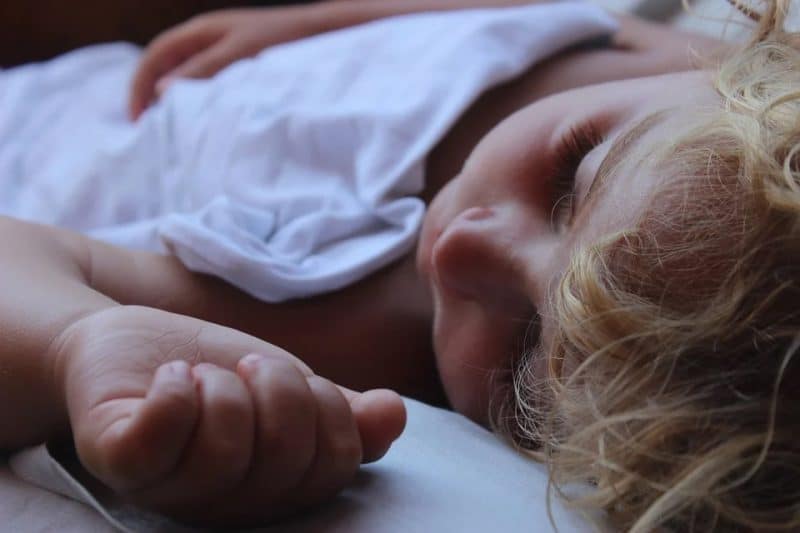The answer to when can toddlers use a pillow is when they are around 18 months old. Remember that while there are so-called baby pillows, a baby can’t use a pillow yet for sleeping. Parents and caretakers must never leave babies with pillows unattended.
Once your little one is around one and a half years old, you can introduce them to a pillow. This age is the experts’ recommendation to prevent SIDS or sudden infant death syndrome. Learn more about kids and pillow usage in this article.

When Can A Toddler Use A Pillow: Everything You Need To Know
When can toddlers use a pillow?
One and a half-year-old
The safest and recommended age for toddlers to use a pillow is when they are one and a half years old. Using pillows or even blankets before a child reaches a year old is unsafe due to SIDS risk, so always remember this age before you introduce such items in their bed or crib. The risk of sudden infant death syndrome for babies and even the sudden unexplained death syndrome for toddlers will drop after your little one turns a year old, but it’s still best to be concerned and careful for a while.
Pediatrician recommendation
Besides their age, you want to check on your child’s personal development. Remember that every toddler will develop uniquely, and some kids may still don’t like having or using pillows and other objects in their bed or crib. You should also consult their doctor for his recommendation regarding the use of pillows.
Sleeping habits
While the age mentioned is when toddlers transition from the crib to a bed with a safety rail or mattress on the floor, it doesn’t always guarantee the need to use a pillow immediately. Observe your little one during sleep and ask your pediatrician if your child is ready. Remember that your toddler must use the pillow correctly as a headrest and not have it pose as a suffocation hazard by placing it over his head.
How to choose a pillow for a toddler?
Timing is not the only crucial part when introducing toddlers to pillows. You should also consider the pillow’s size, materials, and firmness.
Size
Never give a pillow that is too big or too small to your toddler. Like finding the right size shoes, opt for a big enough pillow for a child to support their head and neck. A toddler pillow is significantly smaller and thinner than your standard adult pillow to ensure that it’s not posing a suffocation risk.
Materials
Besides the pillow’s form, check the materials it uses as well because your child may be allergic to the cover or stuffing. If not, the materials can be irritating and cause asthma or skin itchiness. Some pillows that you should be wary of for toddlers are feather and down pillows, buckwheat, microbeads, and even synthetic foam and fibers.
Pillows filled with feathers and down can cause allergies to some children, and synthetic foam and fibers can have an irritating odor. And while buckwheat is a natural material, the small pieces can become a choking hazard like microbeads. Finally, opt for a soft and breathable cover to keep your child cool and cozy.
However, check for its ease of maintenance, so you can wash the pillowcase regularly for hygiene since kids can be messy. It’s always useful to use a pillow with a removable cover to keep it clean weekly and prevent stains and allergens’ buildup. Furthermore, it should be durable to keep the stuffing inside and has no sharp parts to injure a child.
Firmness
Finally, the best pillow for a toddler is flat and firm. While the pillows we use as adults are soft and fluffy, your child will benefit best from a firm pillow with a low loft. It shouldn’t form a dent quickly, so your child is less likely to put it in his face and cause suffocation.
Where Should Toddlers Sleep
Kids between the ages of one to two should safely sleep in a child-proofed crib. It should also be acceptable to add security items like small blankets and stuffed toys om the crib, especially with supervision. However, all the things and the crib itself shouldn’t have small pieces that can break or even strings that your child can reach.
If you notice that your toddler is an active climber, be mindful of items that he can use to elevate himself. The mattress should also be low, or opt for a toddler bed with a side rail. Furthermore, it’s best to place a gate at the room’s doorway to keep your toddler from wandering around the house.
Conclusion
Pillows can provide support and safety to kids, but you must know the introduction’s right timing. This means asking yourself when can toddlers use a pillow, or mainly, when can my toddler use a pillow? Ask your pediatrician about your child’s readiness and observe your toddler’s sleeping habits.
A good time to do these practices is when your little one reaches a year and a half of age. This way, toddlers are at lower risk of sudden infant death syndrome or sudden unexplained death syndrome. Remember that pillows are meant to make sleeping comfortable and cozier and never cause uneasiness and suffocation hazards on your child.
